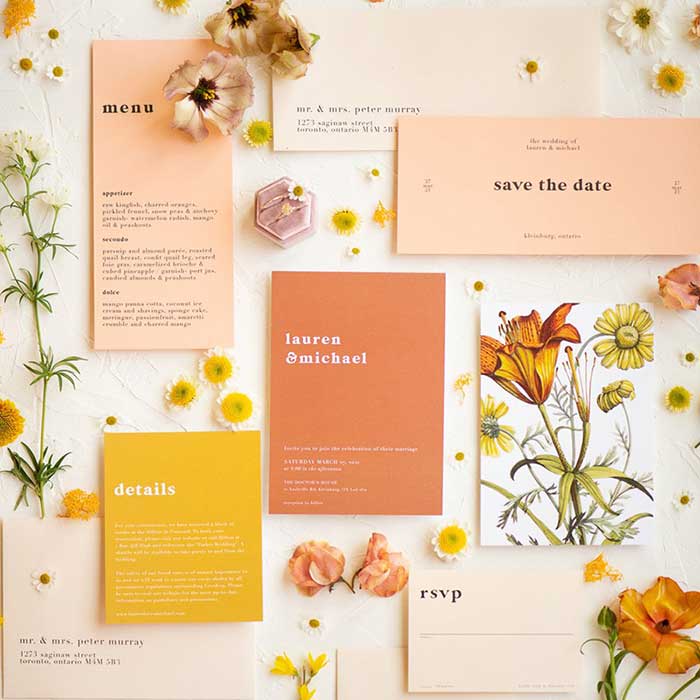E-mail Marketing Techniques for Michigan Wedding Professionals

Table of Contents

Photo sourced from Nearlywed
Introduction to Email Marketing For Wedding Vendors
E-mail marketing is a nuanced subject that requires a delicate approach in order to be successful. E-mail marketing has the ability to influence or overwhelm, so approaching it properly is crucial. We all understand the frustration of a clogged inbox from thousands upon thousands of e-newsletters, digital offers, sale reminders, and promotions. Everyone has signed up for an e-mail list before solely for the purpose of receiving an exclusive discount or offer, only to realize it’s been 10 years and they’re still receiving irrelevant company propaganda, and they unsubscribe.

Photo sourced from Nearlywed
So how do we create authentic, captivating e-mails that contain personalized content and target an audience in a way that leaves them wanting to engage more and engage again? At Nearlywed, we recommend a holistic e-mail marketing strategy that approaches the process from broad to specific and highlights a variety of techniques to focus on. This includes focusing on engagement, content, trends, building e-mail lists, establishing performance metrics, and developing a multi-faceted and cohesive marketing approach.
Creating Engaging E-mails

Photo sourced from Nearlywed
Creating engaging e-mails requires similar strategizing to crafting any engaging digital content. Attention spans for online media are limited, and therefore digital content requires instant user engagement in order to successfully entice a reader into further investigation. Success in crafting an engaging e-mail comes from several key components of content creation, including designing a catchy subject, knowing your audience, personalizing your content, creating a sense of urgency, being succinct and concise, maintaining consistency between e-mails, prioritizing attractive and professional-looking graphics, and urging a call to action.
Design A Catchy Subject
E-mail subjects are the first thing any reader will notice when an e-mail hits their inbox. Most e-mail users are also signed in to their e-mail account on their phone, so when an e-mail notification appears, it is almost instantly noticed and either immediately regarded or disregarded based on subject alone. A catchy subject is critical; it can mean the difference between your e-mail being opened or left completely ignored. Stay away from gimmicky, overbearing subject lines with too many emojis and excessive exclamatory punctuation and instead be clear, concise and authentic. What are you trying to accomplish? What is the body of your e-mail saying? Pick your main point and use that to pull your intended audience in.
Know Your Audience
Knowing your intended audience allows you to create content that plays to your strengths and their weaknesses. This does not mean that you are genuinely taking advantage of your audience’s weaknesses, but rather being intentional with your content creation to draw specific attention to your product or service. If you want to engage your audience, you must know what piques their interest and what will capture their attention past that initial first glance.
Personalize Your Content

Photo sourced from Nearlywed
Personalizing content can take a variety of forms. You can add subscriber names into the body of the e-mail or subject line, use specific anniversaries and dates to engage users, or utilize a tactic called “segmentation,” which is a technique for designing more relevant marketing e-mails for subscribers by segmenting them based on geographic area, individual interests, purchase and browser history, gender, and more (Campaign Monitor). We will break down e-mail personalization and segmentation further in their own sections.
Create A Sense of Urgency

Photo sourced from Nearlywed
Urgency in an e-mail increases the likelihood that a subscriber actually reads it. If they know there’s a deadline on a goods or service offer, the pressure is for them to open and engage. Create urgency in your e-mail marketing by emphasizing keywords and prioritizing deadlines. Be sure to reiterate important dates throughout the subject and body.
Be Succinct and Concise

Photo sourced from Nearlywed
We have consistently expressed the inability for modern readers to maintain an attention span for content they are not immediately engaged by. Disinterest may stem from a number of sources, some of which are in your control and some of which are not. When it comes to content creation, keeping it simple is more likely to enrapture user attention than overcomplicating things. Be concise, clear and get to the point quickly. Adding “too much” to an e-mail, whether that is in the form of graphics or text, can be overstimulating and ultimately cost you engagement. There is a nuanced line to walk between creating content that is “too much” and creating content that is “too little.”
Maintain Consistency
Consistency between e-mails creates a sense of cohesion and professionalism. You have a brand that you are representing, and therefore want your e-mail to represent the whole of that brand. Find a theme you want to adhere to and use it to create continuity between separate e-mails.
Utilize Attractive & Professional Graphics

Photo sourced from Nearlywed
Using professional graphics and imagery elevates your brand. This concept is utilized by bloggers, social media influencers and brands, and website-designers alike. Professional imagery has greater potential to capture viral attention and thus bring traffic and interest to your brand. This is one area in which we do not recommend cutting corners. Invest in quality graphics and imagery to add an edge of sophistication to your brand and content.
Create A Call-To-Action

Photo sourced from Nearlywed
A “Call-To-Action” is a strategy used in many forms of media production. It is designed to stimulate users in doing something, be that engaging with a company, purchasing a product, inquiring about a service, or otherwise. A “call-to-action” influences the reader to engage beyond just perusing and viewing. This is a strategy that creates a sense of urgency and personal responsibility for the subscriber. Be sure to know your intention and desired outcome when crafting your e-mail so that you can create a call-to-action that actually works.
Building and Segmenting E-mail Lists
Building an e-mail list is a critical aspect of customer retention. There are a few things to know when designing and building an e-mail list for your business. A good e-mail list that engages customers and keeps them intrigued in your business always prioritizes consent and permissions, is relevant, accurate, current, and authentic, and is easy to unsubscribe from should the user choose to disengage.

Photo sourced from Nearlywed
Drawing user attention to your e-mail list is crucial. This can be done in a variety of ways, including creating pop-up advertisements that suggest signing up for your e-mail list and conveniently appear across your website pages while user’s scroll; incentivizing your e-mail list with specialty offers, promotional codes, and exclusive discounts and content; and promoting referral programs that offer special deals for subscribers that encourage friends to sign up. Other e-mail list engagement techniques include creating games like “spin-the-wheel” discount opportunities, reminding users at checkout, advertising on your social media, including humorous opt-out answers, and the list goes on. We do not recommend purchasing e-mail lists. Invest your resources in properly building them through appropriate channels instead. This guarantees a voluntary and engaged audience.
Once you’ve engaged users and built an e-mail list, segmentation is an important aspect of successful e-mail marketing. Segmentation, as we previously described, is a marketing technique that segments subscribers based on things like demographic, gender, location, interests, purchase history, and more.
For wedding-based businesses, you can create specific segments that filter categories and target relevant demographics such as future brides, past brides, grooms and by wedding timelines (30 days, 3 months, 6 months, 1 year).
This breaks your subscriber list into groups and customizes the advertised content to purposefully attempt to personalize the user experience and draw attention to your brand. Segmentation is a key aspect of personalizing content, which brings us to our next section.
Personalize Content

Photo sourced from Nearlywed
As previously mentioned, personalizing content is one way to draw user attention to your e-mail. Personalizing content is a strategy that can take a variety of forms, from using a subscriber’s actual name in the subject line or e-mail body, utilizing segmentation strategies to customize content, and sending personalized anniversary messages based on input customer data, to signing your e-mails from an actual person as opposed to a generic company — the options are aplenty. Customers value authenticity over all else, and creating personal content shows that your brand cares about getting to know your client-base on a personal level.
Analyzing Performance Metrics
Tracking and analyzing performance metrics of your e-mail success rates is critical to understanding what works and what doesn’t. Downloading performance reports allows you to visually evaluate the content you have created that has performed the best and engaged the highest number of customers in the way you are intending, be that phone inquiries, e-mail responses, survey replies, product purchases, service inquiries, or otherwise. Every e-mail building and management system (MailChimp, Constant Contact, Hootsuite are all examples) has its own reporting and metrics management algorithm to measure successes and failures.
Pay attention to bounce rates on e-mail blasts. When sending a large volume of the same e-mail to a variety of users, high bounce rate percentages may indicate that the e-mail is being flagged as spam, which could ultimately become a detriment to your business and marketing strategy if your e-mail address is blacklisted. Once an e-mail address is blacklisted for one reason or another, open and delivery rates for those e-mail lists will tank because future e-mails from your company will be blocked from inboxes or immediately delivered to spam folders. Before any e-mail is added to your business e-newsletter list, be sure to scrub it to eliminate any bad or spam addresses.
Pay Attention to Seasonal Trends

Photo sourced from Nearlywed
Paying attention to seasonal and local trends is the perfect way to increase client engagement at certain times of the year. When promoting your brand, understand what products, services and packages will perform best based on seasonal trends and strategize your marketing approach accordingly. Seasonal trends will highlight the importance of timing and frequency in content output. Holidays are a great example of individual days and entire seasons in which it may be more important to schedule frequent content to engage users.
Multi-Faceted Marketing Approach

Photo sourced from Nearlywed
Lastly, we want to highlight the overarching importance of integrating e-mail marketing into a multi-faceted, multi-media approach to advertising. At Nearlywed, we follow a rule of seven: It takes seven interactions with a brand for a prospective client to take action (Forbes). Therefore, we utilize a marketing approach that combines e-mail marketing (e-newsletter) with our digital directory, blog features, digital publication, print publication, social media, and audience accelerators such as targeted advertisements. This means we are not relying solely on our e-mail list to promote your brand, but rather using it as a complimentary aspect of a tiered approach to advertising. This is our best recommendation for a fully-fledged and cohesive marketing approach in the modern digital age.
Email Marketing For Wedding Vendors – Conclusion
E-mail marketing is nuanced. The process is strategic and technical, and following an organized guide on how to approach e-mail advertising will help you develop the proper techniques for your individual brand. What works for you may not work exactly the same for your competitor, but there is a broad set of guidelines you can follow to make the task easier and more successful. We hope these e-mail marketing tips will provide you with a starting point to dive deeper into the realm of e-mail advertising in the modern digital age. When done properly, e-mail marketing is one of the best indicators of client satisfaction and retention. At the end of the day, we are all just trying to build a community of happy customers, and we hope these e-mail marketing techniques will help you get there sooner!
Check Out The Latest on Instagram
Check Out The Latest on Instagram
Follow us on Facebook and Instagram for more tips, resources, and inspiration!

















